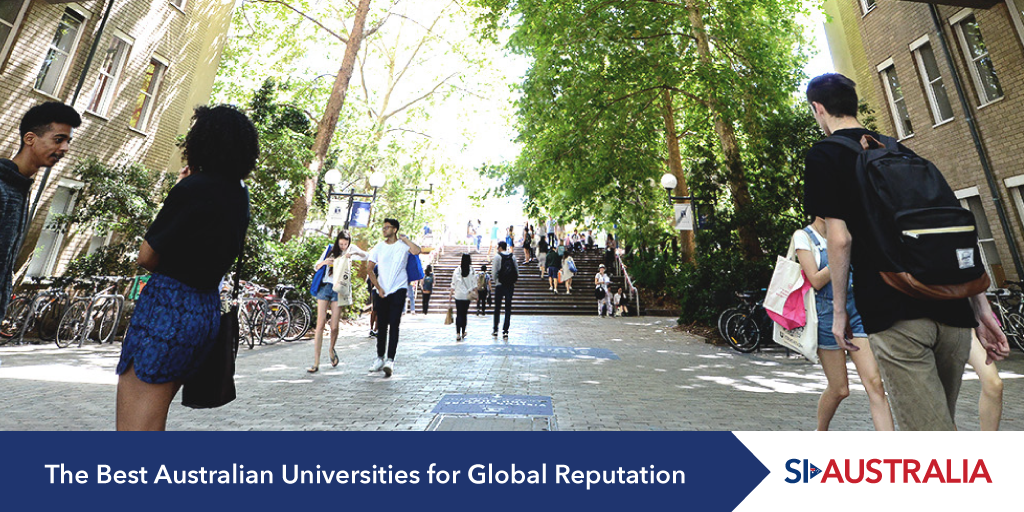The Times Higher Education World University Rankings is an annual analysis of a university's performance globally, using 13 performance indicators to judge research-intensive universities from all points of view.
Six Australian universities have positioned themselves in the top 150 in the Times Higher Education World Reputation Ranking 2023, a small yet significant achievement. These institutions have set a long tradition of accepting international applicants and offering high-quality education with various academic programs and opportunities to undergraduates and postgraduate students.
Learn more about Australian universities in the 2023 World Reputation Rankings below, and to begin your application to study in Australia, arrange a free consultation with SI-Australia today.

Australia’s Best Universities for World Reputation
1. University of Melbourne
The University of Melbourne is a public research university established in 1853 in Melbourne, Australia. It is the second-oldest university in Australia and the oldest in Victoria. The main campus is located in the Melbourne suburb of Parkville, and other campuses across Victoria are Southbank, Creswick, Burnley, Werribee, Dookie, Shepparton, and Werribee.
The University of Melbourne has ten faculties: architecture, building and planning, arts, business and economics, engineering, education, law, fine arts and music, dentistry and health sciences, science, and veterinary and agricultural sciences. The university has an excellent student life, offering world-class facilities, such as libraries, clubs and societies, art galleries and museums, study spaces, and more. It has a global network of 450,000 alumni and donors, such as Opera Singer Nicole Car and former prime minister of Australia Julia Gillard.
- World Reputation Ranking: 51-60th
- Acceptance rate: 70%
- Popular courses: clinical and health, arts, and life sciences
2. University of Sydney
The University of Sydney (Sydney University) is a public research university established in 1850 in Sydney, Australia. It is one of the six sandstone universities and the first to admit students based on academic merit scores. The campus is located across the inner-city suburbs of Camperdown and Darlington, with several satellite campuses.
USYD comprises eight faculties and university schools offering bachelor’s, master’s, and doctoral programs in arts, business, economics, and science. The university has partnered with some of the biggest companies and organisations, like Microsoft, GE, and Qantas, to generate products and services that benefit communities.
- World Reputation Ranking: 61-70th
- Acceptance rate: 30%
- Popular courses: business and economics, engineering and technology, and social sciences
3. Australian National University
The Australian National University is a public research university and a member of the Group of Eight established in 1946 in Canberra, Australia. Studying at ANU allows you to connect with globally-recognised experts and work on solving real-world problems. The university offers around 50 single degrees, 559 flexible double degree programs, and other research-based courses. You can also intern with the Australian government, non-government organisations, and some of Australia’s most prominent private organisations.
The university aims to build your knowledge in small classes taught by global experts and get access to unique industry internships, resources, and support. Besides, ANU has a rich, diverse, and vibrant community with different accommodation options and campus facilities for domestic and international students. Some notable alumni include Kellog’s CEO, John Bryant, and the Foreign Minister of Mongolia, Damdin Tsogtbaatar.
- World Reputation Rankings: 81-90th
- Acceptance rate: 35%
- Popular courses: social sciences, life sciences, and business and economic
4. Monash University
Founded in 1858, Monash University is the second oldest university in Victoria in Australia. It is also the largest university in Australia, named after the engineer, military leader, and public administrator Sir John Monash. The university has campuses across Victoria and Australia and international campuses in Malaysia, Italy, India, and China.
Monash University offers around 6000 courses across ten academic departments: art, design and architecture, business and economics, education, engineering, information technology, law, medicine, nursing and health sciences, pharmaceutical sciences, and science. The university has excellent campus facilities, such as well-equipped labs and research centres, basketball courts, theatres, book and merchandise stores, libraries, and concert halls. Famous alumni include the Booker Prize-winning novelist Peter Carey and musician Nick Cave.
- World Reputation Rankings: 81-90th
- Acceptance rate: 40%
- Popular courses: clinical, pre-clinical, and health, business and economics
5. University of Queensland
The University of Queensland was established in 1909 in Brisbane, Australia, to offer international students exceptional study experiences, research excellence, and an unforgettable lifestyle. It is one of the six sandstone universities having three campuses and more than 40 teaching and research institutes throughout Queensland.
It is one of the best Australian universities, according to the Times Higher Education World Reputation Rankings 2023, offering more than 300 undergraduate and postgraduate courses to students. Apart from academics, UQ is known for its innovation and research, such as developing jet fuels from sugarcane, algae, and food, as well as vaccines and new materials for better battery storage. The campus has several quality study spaces, sports centres, museums, theatres, labs, and libraries to motivate students. Some notable alumni are Olympic Gold-Medal swimmer David Theile and Nobel Prize Winner in Physiology and Medicine Peter C.Doherty.
- World Reputation Rankings: 91-100th
- Acceptance rate: 40%
- Popular courses: arts and humanities, life sciences, and psychology
6. University of New South Wales
The University of New South Wales is a public research university established in 1949 in Sydney, New South Wales, Australia. It is a renowned world-teaching and research institution recognised by employers and organisations worldwide. As a top Australian university, UNSW comprises seven academic departments offering bachelor’s, master’s, and doctoral degrees in business, health, arts, law, and education.
The university has strong connections with industry worldwide, making it the 3rd highest rate of graduate full-time employment. UNSW graduates work with highly reputed organisations and companies like NASA, Google, and UNESCO, thus making the most extensive global alumni network. Campuses have labs, cafes, retail outlets, libraries, childcare centres, and various accommodation options. Some notable alumni include former chairman of the Reserve Bank of Australia Roger Corbett and actress, writer, and director Rebel Wilson.
- World Reputation Rankings: 126-150th
- Acceptance rate: 60%
- Popular courses: information technology, engineering, business, and architecture
Study in Australia
If you want to study in Australia, you can give yourself the best chance of successfully applying by arranging a free consultation with SI-Global today.
THE Rankings - Methodology
1. Teaching: How Efficient are Australian University Classes and Staff?
This is the most essential factor and counts a lot for a future student. Teaching values 30% of the overall score of the university and comprises five small categories-
|
Reputational survey |
15% |
|
Staff-to-student ratio |
4.5% |
|
Doctorate to bachelor’s ratio |
2.25% |
|
Doctorates awarded to academic staff ratio |
6% |
|
Institutional income |
2.25% |
2. Research: Is the research performed relevant?
If you plan to pursue research work in your career, then a PhD degree from a university is essential. THE ranking considers this metric in this parameter. The research category holds an overall percentage of 30% that is divided into the following categories:
|
Academic reputation survey (reflects how well-regarded the research published by the university is among other academics) |
18% |
|
Research income (budget of the university to invest in research work) |
6% |
|
Research productivity (how much work academics at the university publish in peer-reviewed journals) |
6% |
3. Citations: How Often are Authors Cited in Books and Articles?
Citations are the third indicator and are as important as the previous indicators. It holds an overall weight of 30% and measures how much influence the research produced by a university has on the outside world. They are measured by counting the times the scholars cite the university’s published works.
4. International Outlook: Is the University Relevant to the International Community?
This is the most crucial factor for those looking to study abroad. If you are an international student, you look for the International Outlook metric to understand its relevancy. This indicator holds an overall percentage of 7.5 and is essential because a well-performing university naturally attracts the international student community. It is mainly classified into three main categories -
|
Proportion of international students |
2% |
|
Proportion of international staff |
3% |
|
International collaboration |
2.5% |
5. Industry Income: Do Businesses Give Credit to the University?
The industry income represents 2.5% of the score and is the most relevant in today’s modern and dynamic world. It indicates the impact of the university apart from academics and research. The industry income measures how much funding it has received from other industries and companies from different sources in exchange for their research and development. Overall, it defines how well the university attracts this kind of attention from companies.















































































